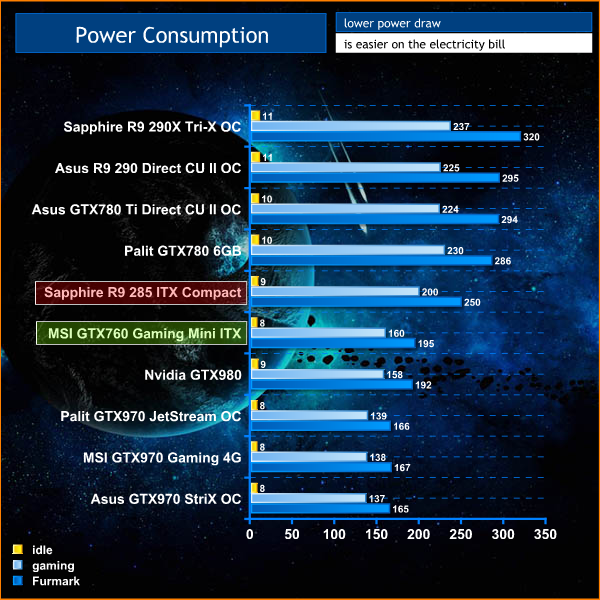To test power consumption today we are using a Keithley Integra unit and we measure power consumption from the VGA card inputs, not the system wide drain. We measure results while gaming in Tomb Raider at 4k resolution and the synthetic stress test Furmark – recording both results.

The Sapphire R9 285 ITX Compact is the more power hungry graphics card, taking around 200 watts when gaming. This rises to 250 watts under synthetic Furmark load. The MSI GTX760 Gaming Mini ITX by comparison only takes 160 watts when gaming.
Obviously when we compare these Mini ITX solutions to the latest Nvidia Maxwell architecture we can see massive differences. The reference Nvidia GTX980 demands 2 watts less than the GTX760 we tested today when gaming. Incredible really.
 KitGuru KitGuru.net – Tech News | Hardware News | Hardware Reviews | IOS | Mobile | Gaming | Graphics Cards
KitGuru KitGuru.net – Tech News | Hardware News | Hardware Reviews | IOS | Mobile | Gaming | Graphics Cards


Why are many reviewers of the R9 285 card saying that it has 32 ROPs when it has 64 ROPs? (GPU-Z) its funny because they state that it has 32 ROPs and they have a picture of GPU-Z saying 64 in the same page lol
The fact that the Sapphire card is able to consume so much more power and stay cool and quiet while being that size really is quite impressive, and I hope it means we see more high-end cards in that form factor. But yeah also means the new 970 ITX that’s coming will likely stomp it quite badly, 20nm can’t come soon enough!
970 is in other range of performance, but product and price too. it would be more comparable to a itx 960 or 950 ti.
That is very fair and I must admit I didn’t even consider what the price difference is, I was mainly thinking from a performance in ITX perspective.
I have this exact problem: GPU-z the latest version says 32 ROPs whereas most of the online reviews of the R9 285 ITX state 64 ROPs. Does anyone have a clue what the issue is here? Software bug in GPU-z? Thanks.